|
|
|
|
Contact:
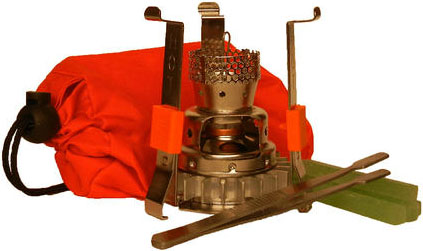
Raymond Gatt of Gatt-Gen released his G-Micro PSL (Personal Stove and Light) wax gasifier stove to the public sometime around 2011. It was originally marketed as a survival stove and light which will run off of alcohol and solid wax sticks. It is important to note that Raymond Gatt now markets the G-Micro PSL as a Wax only stove and light and no longer endorses the use of alcohol or other liquid fuels in his stove (more on this later). Even without the ability to use alcohol in the G-Micro PSL, a wax fueled stove makes for a potentially useful cooking system. Solid wax fuel allows you to safely store your stove and fuel in your car, garage, or closet. And since solid candles are allowed by the TSA in the US, the G-Micro and fuel can be packed in checked baggage for air travel or even mailed to your destination. This stove and light system opens up new possibilities for survivalists, disaster preppers and international travelers.
Solid wax also has considerable amount of heat potential per gram. Because of this, many ultralight hikers have experimented with various wax powered stoves in hopes of making an ultralight cook system which would allow for minimal stove and fuel weight. And if the G-Micro PSL published specification are near accurate, it has the potential of being a light weight stove contender for many.
Related Links:
US Patent Publication US 2011/0239539 A1 - MELTABLE FUEL GAS GENERATION APPARATUS AND METHODS
YouTube oNlg4X1DFWM - Wax Fueled Gas Generator
YouTube WRLqPWDfE2U - G-Micro PSL (Personal Stove & Light) Instructional
YouTube LhlMl6zPVaA - G-Micro PSL - Personal Stove & Light (Fueled with De-natured Alcohol)
Manufactures Specs
The following specs were available at gattgen.com at the time of this review:
Burner weight 2.1oz - 60g
Stand weight 1.7oz - 48g
Cooling Ring 0.3oz - 10g (for hot climate / Removable)
Burner 1.5dia x 2.25h
Stand 2.75dia x 3.25h
WAX MODE
Fuel Pure Paraffin Wax (Wax Stix, Candle Pieces , Etc)
Burn time full reservoir 30min
Paraffin wax consumption 26g/hr 0.91oz/hr
1,100 btu/hr (wax mode)
Boil cold water (Max 16oz [2 cups, 462mL]) at less than 1 min per oz.
ALCOHOL MODE [see Note below]
Fuel Ethanol Alcohol
Burn time full reservoir 15min
Note: After initial tests of the G-Micro by zenstoves.net, Gatt-Gen stopped marketing the G-Micro as Wax or Alcohol stove. It is now being marketed solely as a solid Wax fueled stove. This was due to the inherent dangers of using liquid fuels made evident by the image of a pot engulfed in flames from overfilling the G-Micro with alcohol shown below. The G-Micro can still run on alcohol and various other combustible liquids, and the danger of using these fuels are also still present.
Raymond Gatt's G-Micro PSL Facebook Page gives you a peek at the G-Micro PSL.
Raymond Gatt's first entry:
"To the G-Micro PSL "Worlds First" Solid Wax Powered Gas Stove & Light.
The tiny G-Micro PSL Stove & Light thermal device itself weighs 3 oz including a 30min fuel reservoir which can be continually re-fueled with wax when burning. No other gas stove can do that and also no wasteful pressurized throw away canisters to buy."
And his images of the Facebook G-Micro PSL gives you an idea of the G-Micro PSLs is and can do:
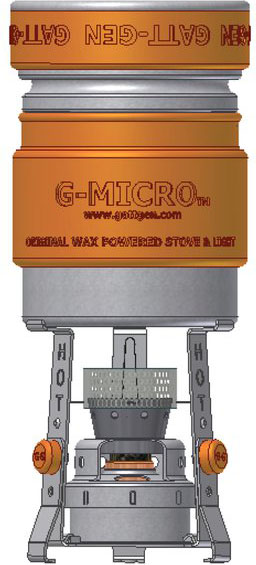
Here a concept drawing is shown with the G-Micro PSL stove and what appears to be a pot the size of a soup can which should also double as a pot.
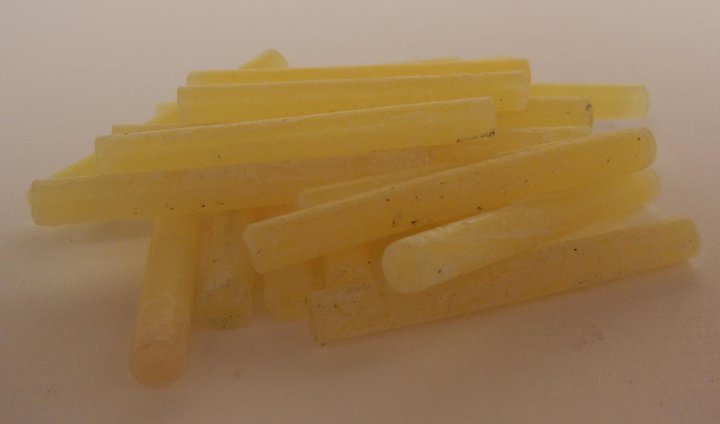
Here are example was sticks for the stove. The G-Micro PSL has a small filler hole which allows you to add these sticks whole or broken up. An entire stick can not be placed inside the stove all at once, but can be left protruding so that it melts into the hole. The box of Wax Stix I received were light green in color and were square rods which packed a little better than round rods.
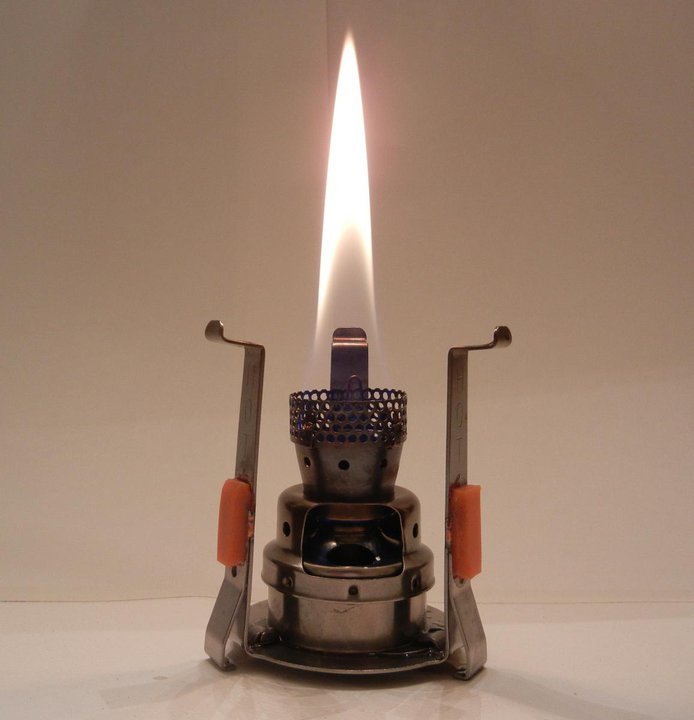
Here is the G-Micro PSL demonstrating a large luminescent light. This appears to be more or less a giant candle flame, which reportedly can be used with a globe to light up a tent or room.
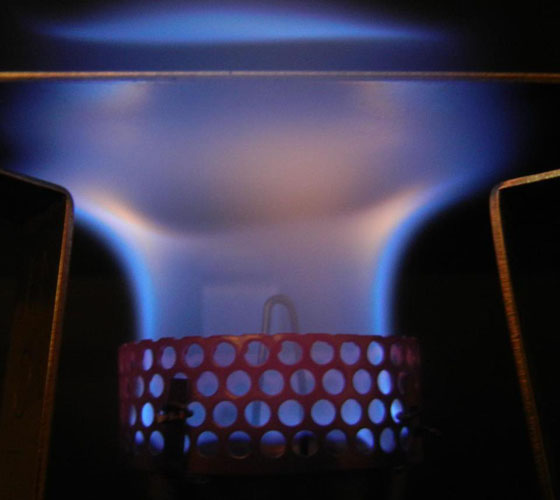
Here is what appears to be the G-Micro PSL burning was with a pot over it. Note that the flame is touching the bottom of a pot.
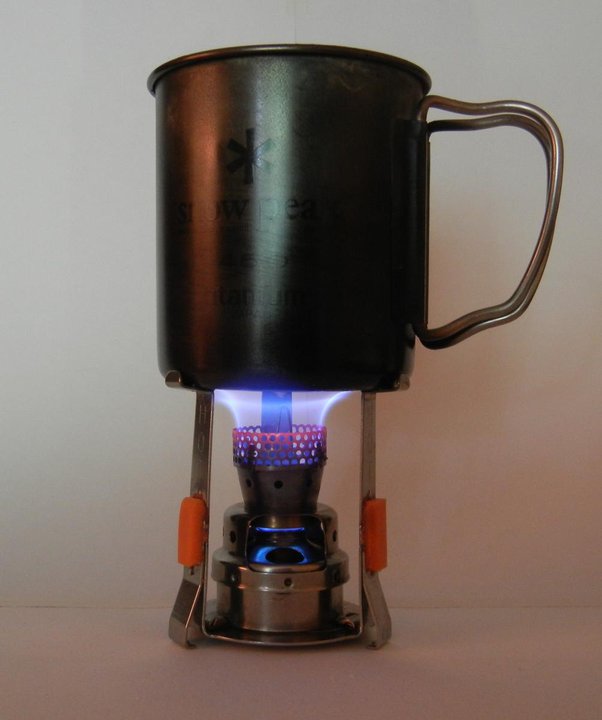
Here is the G-Micro PSL with a Snow Peak mug over it. Note how flame stays centered on bottom of mug with minimal flame traveling up the side. Also note how the mug is covered in what appears to be burnt wax.
Zen Seeker G-Micro PSL Wax Gasifier Review
After seeing the Raymond Gatt's wax gasifier video and being a stove enthusiast, I was naturally excited about the potential of the Raymond Gatt's G-Micro PSL. This stove technology has several features which would appeal to many outdoorsmen, survivalists, disaster relief personnel and international travelers alike.
Potential plusses for the G-Micro PSL:
solid wax fuel allows for long term safe storage
fuel is waterproof and spill proof when solid
fuel and stove can be placed in checked baggage for domestic or international air travel
stove originally marketed as a duel fuel stove which burns alcohol [see Note below]
solid wax has great energy to weight ratio
minimally sized stove for solo use
something new
Note: After initial tests of the G-Micro by zenstoves.net, Gatt-Gen stopped marketing the G-Micro as Wax or Alcohol stove. It is now being marketed solely as a solid Wax fueled stove. This was due to the inherent dangers of using liquid fuels made evident by the image of a pot engulfed in flames from overfilling the G-Micro with alcohol shown below. The G-Micro can still run on alcohol and various other combustible liquids, and the danger of using these fuels are also still present.
Particularly interesting is the possibility of a stove system which could be packed with fuel and checked at the airport. This means that certain international travelers can show up at their destination ready to cook without the need for electricity or time required to locate special fuels. And depending on your travel style, this can be a big deal.
It would also be interesting to see how efficiently the G-Micro PSL can harness the heat potential of wax. Combined with the light weight of the G-Micro PSL, the use of wax creates the potential for a very light weight stove system.
The following is Zen Stoves' review of the G-Micro PSL Wax Gasifier Personal Light and Stove.
G-Micro PSL Stove Components
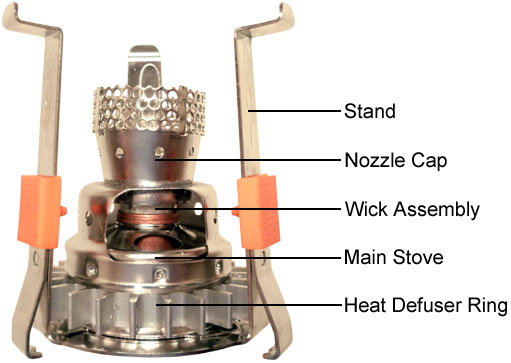
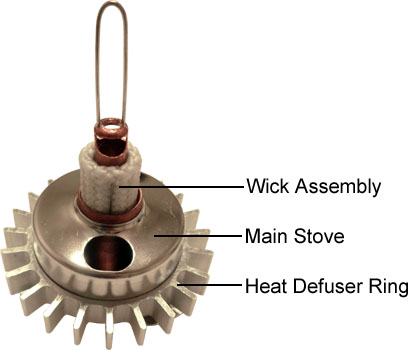
The stove is made up of 6 separate pieces. There is the Main Stove, a Wick assembly, a Nozzle Cap, a Stand, Heat Defuser Ring and Tweezers.
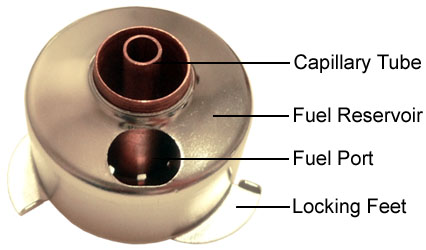
The Main Stove has a Fuel Reservoir and Capillary Tube where the wick fits in. The Fuel Reservoir holds both solid wax and liquid fuel. The Fuel Port allows you to add wax or liquid fuel. The Capillary Tube holds the Wick Assembly and allows for thermal feedback to the stove to melt and preheat fuel. The locking feet allow you to lock the Main Stove to the stand. The center tube is brazed to the bottom of the stove and has a hole in the bottom floor of the stove. This likely allows some air to be drawn in from the bottom of the G-Micro up through the middle of the Wick assembly and out into the chamber created by the Nozzle Cap. If you look into the fuel port, you can see the weep holes created by the bottom of the copper inner wall in the fuel reservoir. These openings allow liquid fuel to enter the inner chamber and come in contact with the Wick Assembly. The feet of the inner wall fan outwards in the outer chamber of the G-Micro to allow for more effective melting of wax.
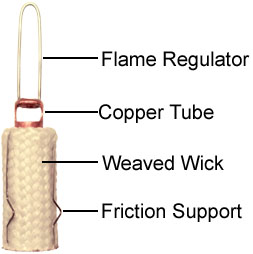
The Wick Assembly is made up of a weaved fabric tubular Wick with a supporting metal structure. I've taken the liberty of naming the main parts of the wick. The Weaved Wick obviously draws liquid fuel upwards from the Fuel Reservoir and allows for burning liquefied fuel (melted wax) just like a candle wick. Within the weaved fabric wick is what appears to be a copper tube. The Copper Tube gives support to the Weaved Wick and likely aids in thermal feedback to the stove to melt wax in the fuel reservoir and to aid in vaporizing fuel on the wick. Several Friction Support Wires run down the outside of the wick. These help hold the wick against the Copper Tube and holding friction against the inner wall of the stove reservoir. The combination of the inner Copper Tube and outer Friction Support Wires allow you to move the wick up and down and without the wick binding, slipping down later or falling out while you nurse the wick. The Flame Regulator up top appears to be a loop of stainless steel. This gives you something for your tweezers to grab onto so that you can adjust your wick height up and down. It also seems to keep gasified fuel ignited.
Note: You should avoid pulling the wick upwards beyond where the triangular bend in the Friction Supports engage the stove. Pulling out the wick beyond this point can cause you to pull the wick out completely, which can be problematic as it may be difficult to get the wick back in without unraveling the bottom of the wick. If you would like to remove a used wick from your stove, make sure there is some wax on it (don't run stove dry) and allow it to cool enough to allow for handling. Slowly pull the wick out and allow it to harden before reinstalling it in the stove.
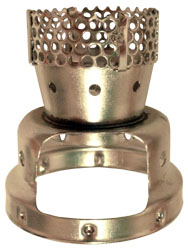
The Nozzle Cap allows for a chimney effect and mixing of heated gasified fuel and oxygen while insulating the heat produced by combustion of these mixed gases while also protecting them from wind. The lower half of the Nozzle Cap is designed to fit snuggly over the Main Stove. There is an opening on one side of the lower half which allows you to add fuel to the Fuel Port, assuming you line up the Nozzle Cap correctly over the Main Stove. This opening and other ventilation holes allow air to be drawn over the wick and in the upper half of the Nozzle Cap.
The Tweezers allow you to add wax to the stove while lit and adjust the wick height without burning your hands.
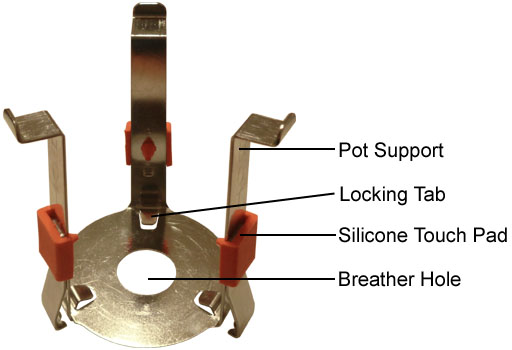
The Stand allows you to place a pot over your stove and allows you to hold your stove with your bare fingers while lit. Holding the stove sideways is necessary during initial lighting of the wick so this stand is nice to have. The stand also holds the Main Stove Body just a little off of the ground. This prevents burning of your ground surface, loss of heat from direct contact with a frozen ground and allows some air to travel under the stove and up through the middle of the Tubular Weaved Wick. The three locking tabs on the base of the Stand allow you to lock your Main Stove Body to the Stand.

According to Raymond Gatt, the Heat Defuser Ring helps cooling of the stove in hot environments. This might be needed to help reduce the event of boil over of liquefied fuel which can both be messy, wasteful and potentially cause a fire hazard. This Heat Defuser Ring appears to be made from machined aluminum with a steel spring which resembles a binder clip to allow it to expand and fit tightly around the Main Stove.
According to Raymond Gatt:
"The Cooling Fin accessory will lower the temperature of the molten wax in the reservoir when ambient temps are high 90ºF +. The flame will pulse if the Reservoir wax temp gets too high and the Cooling Fins will stop the pulsations. The fins can be easily removed and easily installed if required. Most users in North America will rarely need to use the cooling fins."
What is missing is a windshield. This is vital for use with this stove for anything other than indoor use.
Component Weights
| Component(s) | oz | gm |
| Main Stove | 1.3 | 36 |
| Wick | 0.3 | 9 |
| Nozzle Cap | 0.6 | 17 |
| Stand | 1.8 | 50 |
| Heat Defuser Ring | 0.3 | 10 |
| Tweezers | 0.5 | 13 |
| Assembled Stove | 4.3 | 122 |
| Assembled Stove with Tweezers | 4.8 | 134 |
| Assembled Stove minus Heat Ring | 3.9 | 112 |
| Assembled Stove with Tweezers and minus Heat Ring | 4.4 | 125 |
Stove Setup and Use
Lighting can be difficult or impossible in windy conditions, but is doable once you figure out how to do so. There are a lot of steps and it may be daunting at first. Lighting the stove becomes much easier after you work on it s few times and after wick break in.
Wax Mode
Here are the steps for burning wax fuel:
Lock Reservoir on stand if separated
Add small pieces of wax to filler hole if needed
Remove the Nozzle Cap - you may need to remove any hardened wax by heating it up first
Make sure there is wax on the wick - if dry, melt some wax onto the wick
If the wick isn't frozen in place by hardened wax, bottom out wick and pull it up just a bit. Do not pull the Wick Assemble up past the triangular bend in the Friction Support Wires. If you pull it up too much (greater than 3/8th inch or 10mm), you'll pull it out completely and may not be able to get it back in as the end can unravel.
Roughen up wick with sandpaper (needed early on before wick break-in and when unfamiliar with the stove)
Hold stove by stand and turn sideways
Protect stove from wind if necessary - use anything possible to shelter wick but a purpose made windshield is ideal
Use a lighter, match or lit candle close to wick to melt wax
Rotate stove and melt wax on other side of wick.
Pull flame for your lighter downwards so that melted wax ignites from the tip of your flame
Carefully rotate stove so that flame spreads around wick
Set stove upright on ground inside windscreen
Wait for the flame to grow - you want it to get good and hot and have a nice large flame
If necessary (for dry wick), melt a little wax on the wick by rubbing the wick gently with a stick of wax
Adjust wick height with tweezers. If flame is weak, pull it up a bit (not greater than 10mm from bottom) and allow for flame to grow.
Install Nozzle cap. Push it all the way down so that it bottoms out.
- Optional: hold Nozzle Cap with tweezers over flame to preheat it before installing it. If done right, this will also ignite gasified fuel within the cap as you slowly lower it over the wick.
Depending on ambient light, you may notice smoke or steam rising from the stove - this is gasified wax waiting for your flame
Relight your stove.
You may need to add a few drops of wax into the nozzle to get it going.
If you fail to relight your stove - start over with more wax and the wick pulled out higher.
If you get your stove to light, let it warm up again.
Use your tweezers to bottom the wick to its lowest position.
Place pot on stove
Add Wax as needed.
Extinguish by blowing out like a candle or dropping an empty can over stove - this will produce a significant amount of emissions so dropping a can over the stove is preferred if using this stove indoors.
Raymond Gatt points out that in his experience this is the sequence of events required to light the PSL after it has been broken in i.e. lighted 2X.
Remove the Nozzle Cap by slightly rocking it.
Hold stove by stand and turn sideways
Use a lighter or match close to wick to melt wax. (Ideally stove was extinguished with enough wick exposed for re-light)
Pull flame downwards so that melted wax ignites
Carefully rotate stove so that flame spreads around wick
Set stove on ground inside windscreen (if outdoor) let sit until flame is strong
Install Nozzle cap. Push it all the way down so that it bottoms out.
Let stove heat up about one min then light Wax Gas plume.
Adjust wick / flame height using tweezers supplied or other non flammable tool.
PSL is ready to use as light source or to cook
Add wax fuel as required for as long as needed
Raymond Gatt's video demonstrates this:
Gatt also points out that the MSR Dragonfly has 19 steps.
Alcohol Mode [see Note below]
Use with alcohol is much easier. The only challenge would be getting liquid fuel into the tiny fuel access hole. You will need a syringe or bottle with a small nozzle, otherwise expect to spill some fuel. Raymond Gatt clearly pointed out that the stove must to be cool and not lit when refilling the stove with liquid fuel. This it to prevent ignition and possible explosion during refilling.
Contrary to what Raymond Gatt recommends and what common sense would suggest, I was able to add liquid alcohol straight into the fuel hole with a syringe while the stove was running. I just made sure that the tip of the syringe was in the filler hole before injecting fuel in it. Refueling a lit stove with liquid fuel of course has the potential for problems and should not be done by the general public [see below].
Note: After initial tests of the G-Micro by zenstoves.net, Gatt-Gen stopped marketing the G-Micro as Wax or Alcohol stove. It is now being marketed solely as a solid Wax fueled stove. This was due to the inherent dangers of using liquid fuels made evident by the image of a pot engulfed in flames from overfilling the G-Micro with alcohol shown below. The G-Micro can still run on alcohol and various other combustible liquids, and the danger of using these fuels are also still present.
Fuel Tests
Several fuels were tested with the G-Micro PSL, with mixed results.
NOTE: The G-Micro PSL is marketed as a solid wax fueled stove. The manufacturer does not endorse use of any liquid fuels in their stove. The following tests were conducted for experimental reasons only and were conducted by someone with a good deal of experience with fire. The following is provided for educational purposes only and is not an endorsement to use the G-Micro PSL with fuels it was not designed for or even for fuels that it was designed for.
Tested and considered fuels include:
Crayons - considered only
70% Isopropanol rubbing alcohol - without Nozzle Cap
70% Isopropanol rubbing alcohol - with Nozzle Cap
91% Isopropanol rubbing alcohol
99% Isopropanol rubbing alcohol
Plant Oil - Unsuitable fuel for stock G-Micro PSL
White Gas - Unsuitable fuel for the G-Micro PSL
Automotive Gasoline - considered and rejected
Methanol, Denatured alcohol and paraffin wax performed the best. Isopropyl alcohol and beeswax performed poorly and were quite disappointing.
The following tests were performed with:
G-Micro PSL stove
Stove filled with fuel (15cc/0.5fl oz)
Pot -19oz soup can with top removed
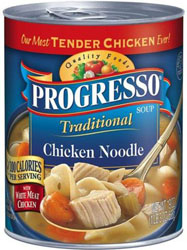
2 cups (~473mL) of cold tap water
No windscreen was used to allow for better photographs
Lid - another can
butane stove lighter
10cc medical syringe for filling stove with proper amount of liquid fuel
Recommended fuel by manufacturer. The supplied wax sticks are light green in color are are reportedly 100% Paraffin wax with a tint of green aniline dye. They are sized just right to add to the small filler hole on the side of the stove.
Gatt-Gen uses green to signify 145F Melt Point wax, Yellow for 135F Melt Point wax and Red for 185F Melt Point wax. So the wax supplied by Raymond Gatt is should be 145ºF wax.
The stove was very easy to fill with the Wax Stix as they were cut into proper sized rectangular rods. There was no need to cut up any wax for fueling. This fuel was tested after several other fuels, so knowledge on how to work the wick and stove was better than with beeswax and tea light candle wax. The stove was held sideways and a disposable Bic lighter was used to engulf the wick with flame. This melted wax on the bottom half of the wick. The stove was turned 180 degrees and the lighter was used again to melt the second half of the wick. The stove was then flipped back 180 degrees, the wick was again engulfed with flame and then the lighter was lowered so that the tip of the flame ignited the "wet" wick. Minimal time was required to nurse the wick and it was unnecessary to wait for the wax in the stove to melt. Modified tweezers were used to hold the Nozzle Cap over the burning wick. This protects the flame from wind and reflects some heat back at the wick. It also preheated the Nozzle Cap and quickly turned in inside of the Nozzle Cap red hot. The Nozzle Cap was then slowly lowered so that fuel gasses could rise through the center of the Nozzle Cap and ignite. The Nozzle Cap was lowered all the way down until it bottomed out on the Wick Assembly with the G-Micro still lit. As the wick was left somewhat high in the Stove Body during its previous use, it was frozen in wax and prevented the Nozzle Cap from fully seating on the Stove Body. After a short period of the stove burning, the stove melted enough wax to allow the wick to depress into the stove and then allow the Nozzle Cap to properly bottom out on the stove.
The stove burned well. Flames were blue and yellow and continued to stay lit with the wick all the way up and with the wick all the way down.
The stove brought two cups of water to boil before running out of fuel. After running out of fuel there was the expected smoldering phase which pumps out smoke and a strong burning paraffin smell. Placing a can over the stove would help reduce both.
Black staining of the pot was substantial. This left a layer of half burnt wax and greasy soot. An abrasive pad a some effort was required to remove this.
Parowax Household Wax is available is many US grocery stores in the canning section. It comes in a small cardboard box with four 4oz blocks of white wax. The blocks were somewhat deformed from likely being overheated and locked together in one giant block. With some effort, two of the 4oz blocks could be separated. Sticks were cut from one block with a knife and further trimmed with a pair of scissors. After the G-Micro was run dry, it was loaded up with Parowax chunks and the wick was primed with Parowax. It started up fine and required some rubbing with a Parowax stick to "treat" the wick. After running the stove for some time to "clean out" any other fuel, the fuel reservoir was topped off. The stove was then extinguished and allowed to cool off for this experiment.
The cold G-Micro PSL wasn't difficult to light up. After minimal nursing of the flame, the stove warmed up without event and the Nozzle Cap was lowered over the wick to preheat the Nozzle Cap and then installed on the G-Micro PSL. The gasified fumes lit up easily with a lighter and a pot was placed on the stove.
The flame had more yellow than anticipated but continued to burn without event. At around 23min, the pot reached an early boil (pot making noise). The G-Mico PSL continued to burn for a total of 35 minutes.
The pot's bottom was blackened and coated with a thin layer up unburned black wax. Wax buildup was greater than what was seen with the tea light wax experiment and less than what was seen with the Wax Stix experiment.
This is believed to be the same "Gulf Wax" recommended by Raymond Gatt. He feels that the G-Micro PSL can run on any substantially pure paraffin nominal 145F wax such as Gulf Wax. This wax comes in 1 pound boxes found in many large grocery chains in the US in the food canning section. At WalMart, it may be in the grocery section with pectin and not in housewares where the majority of canning supplies can be found.
Gulf Wax is distributed by Royal Oak Sales, Inc. in Roswell, GA. Royal Oak reportedly purchases their paraffin from Exxon through a broker.
The box of Gulf Wax tested came with 4 slabs of quarter pound sections of paraffin which were fused together which made a solid one pound block. These 4 sections were resistant to separation and remained as a single solid block after several attempts at breaking apart the sections. If you take a knife to the wax, you can cut out sticks of wax which break off cleanly at the boarder of each section. This wax seemed "soft" and easy to cut up and melt.
This wax was relatively easy to light in the G-Micro PSL and comparable to the other paraffin wax fuels tested. A full reservoir of Gulf Wax in the G-Micro PSL continued burning for a little over 30 minutes.
Unburned wax build up wasn't so bad compared to Parawax and Wax Stix experiments.
Tealights seem like a great potential fuel. It is not clear if these are made from 145F wax. They are easy to pack, easy to cut up and can be used as an emergency light, heat, fire started, waterproofer, zipper lube, etc. If you are having problems getting your G-Micro PSL to start, you can use a tealight to heat up the stove to loosen a frozen wick, drip wax onto the stove's wick and use the tealight flame to start the stove's wick without concern of damaging your lighter.
The tealight candles were easy to cut up into small pieces for the stove. It was relatively easy to light the G-Micro PSL with the tealight. Like other fuels tested, the G-Micro PSL's flame was very difficult to see in the daylight. At night, the flame was more evident and it was rather easy to light the G-Micro PSL's wick with a burning tea light candle. The Nozzle Cap was slowly lowered over the burning wick so that the middle of it turned red hot and ignited the gasified wax rising through the center hole. There was a small breeze which the flame didn't like, so a windscreen had to be used intermittently to protect the flame. Before the prefilled stove ran out of fuel, the G-Micro PSL brought two cups of water to a boil.
These was some blackening of the pot.
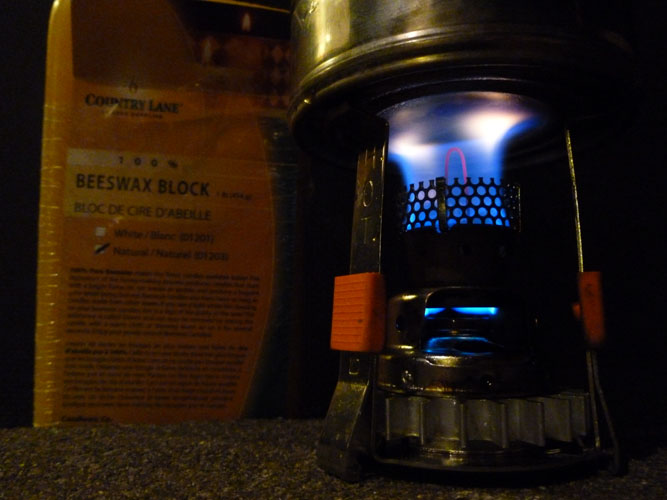
Not a Recommended fuel.
Beeswax was difficult to get going and once going burn much "cooler" than regular paraffin wax. The smell was pleasant compared to burning parofin and it left minimal staining on the bottom of the pot. The tank full of beeswax failed to get two cups of water to a boiling point.
The most challenging part of using beeswax was getting a big block of wax into the stove's tiny filler hole. With a bit of pre-preparation, you can cast your own wax stick for easy filling. For this experment, shaved off chunks of wax were used and added to the G-Micro PSL one bit at a time with the supplied tweezers. This works, but a good deal of wax melted all over the stove and fingers were coated with a thin layer of soft beeswax.
Refilling the stove while in use is possible with wax. Tweezers should be used to avoid burns, but it is possible to use unprotected fingers to get larger chunks in the right place. Once larger pieces were placed in or over the filler hole, tweezers were used to push the wax in the proper direction.
Further tests will need to be performed with with beewax tealights to fuel and ignite the G-Micro PSL. The beeswax experiment was also performed prior to full break in of the G-Micro PSL's wick.
Crayons weren't tested during these tests, but Raymond Gatt says he has tried them in the past. According to Gatt, crayons will work as fuel in a pinch, but the color tint seems to clog up the wick so this fuel is not recommended for the G-Micro PSL.
Ethanol Fuel - Denatured Alcohol
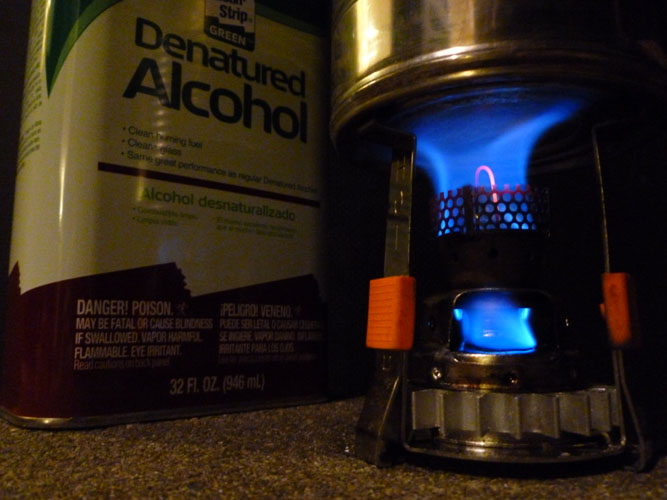
Recommended fuel by manufacturer.
Note: when I received the G-Micro from Gatt-Gen, it was marketed as both a Wax and an Alcohol Stove. After initial findings of this review were posted showing a stove and pot engulfed in flames from overfilling with alcohol, Gatt-Gen opted to change marketing for their stove to just being a solid Wax Stove. Liquid fuels such as alcohol presents a spill hazard, can boil over and overheat a stove. Flammable liquid fuels present a serious fire hazard when added to a lit or hot stove.
This is a fine working fuel with a familiar smell. It was very easy to light. The stove was filled with 15cc of denatured alcohol and a small amount was squired into the Nozzle Cap already installed. Note that the stove was cold and not lit when alcohol was squirted on the stove. The alcohol in the nozzle cap was used to prime the stove and this fuel allowed for a quick start up of the stove. The flames danced around a bit and casually edged over the bottom of the pot to touch the side of the pot.
No soot was left on the bottom of the pot.
Refilling with a syringe was possible with the G-Micro PSL lit. This was done during several experiments with a medical syringe filled with up to 10ccs of fuel. NOTE: Refueling of a lit G-Micro PSL was preformed for experimental reasons and there is a real potential burn hazard whenever refueling a lit stove with liquid fuel. Any fuel on the outside of your syringe, hands or work area can instantly ignite. There are any number of things which can happen during refueling such as failure of the syringe, tipping over of the stove or knocking over an open fuel bottle which can result in a catastrophic event. Therefore, refueling of a lit G-Micro PSL with liquid fuel in not recommended.
Methanol Alcohol Fuel - Yellow HEET
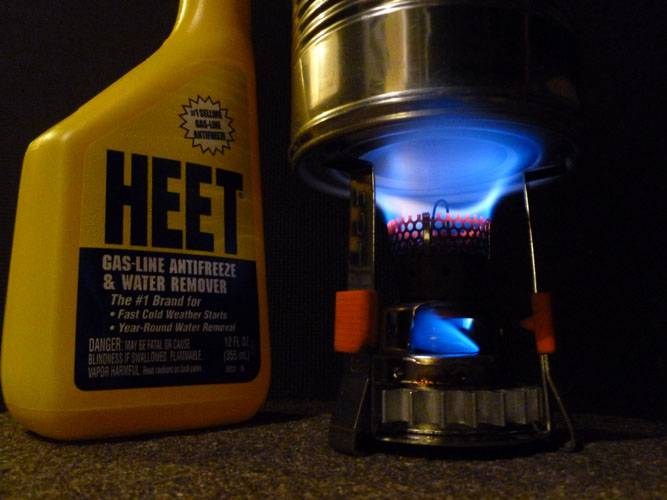
Not a recommended fuel by manufacturer.
Note: This fuel was never recommended by the manufacture of the G-Micro PSL. When I received the G-Micro from Gatt-Gen, it was marketed as both a Wax and an Alcohol (ethanol) Stove. After initial findings of this review were posted showing a stove and pot engulfed in flames from overfilling with alcohol, Gatt-Gen opted to change marketing for their stove to just being a solid Wax Stove. Liquid fuels such as alcohol present a spill hazard, can boil over and overheat a stove and can be very dangerous if added to a lit or hot stove.
Yellow HEET is more or less straight methanol. This is easy to find throughout many parts of North America at gas stations, auto parts stores and stores such as Wal-Mart. It burns easily in the most basic of "stoves" and seems to burn finn in the G-Micro PSL. It has a well behaved flame and starts easily without a hitch.
No soot was left on the pot.
Refilling with a syringe was possible. This was done during several experiments with a medical syringe filled with up to 10ccs of fuel.
NOTE: Refueling of a lit G-Micro PSL was preformed for experimental reasons and there is a real potential burn hazard whenever refueling a lit stove. Any fuel on the outside of your syringe, hands or work area can instantly ignite. There are any number of things which can happen during refueling such as failure of the syringe, tipping over of the stove or knocking over an open fuel bottle which can result in a catastrophic event. Therefore, refueling of a lit G-Micro PSL with liquid fuel in not recommended.
Isopropanol Alcohol Fuel - Red Iso-HEET
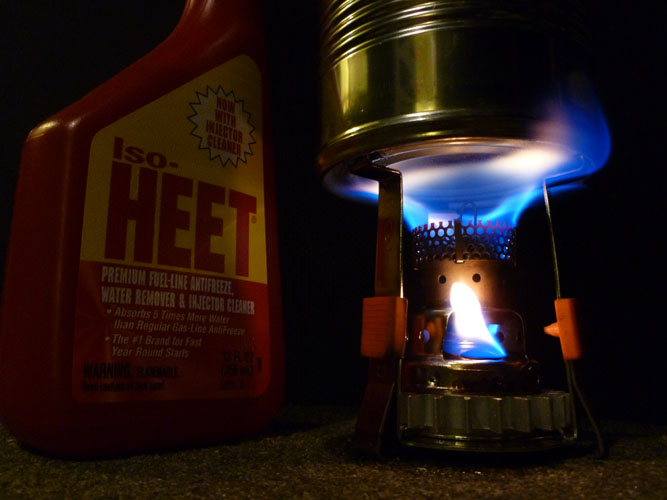
Not a recommended fuel.
Note: This fuel was never recommended by the manufacture of the G-Micro PSL. When I received the G-Micro from Gatt-Gen, it was marketed as both a Wax and an Alcohol (ethanol) Stove. After initial findings of this review were posted showing a stove and pot engulfed in flames from overfilling with alcohol, Gatt-Gen opted to change marketing for their stove to just being a solid Wax Stove. Liquid fuels such as alcohol present a spill hazard, can boil over and overheat a stove and can be very dangerous if added to a lit or hot stove.
Red HEET is an antifreeze fuel additive used in places where the temperature drops below freezing. Note in the picture, the HEET bottle says "NOW WITH INJECTOR CLEANER" which may account for the odor it gave off when burned. It seemed to do fine at the start. It was easy to light and as you can see in the image above, it had a very luminescent yellow flame mixed with a blue flame. The flame traveled up the pot a bit.
Shortly into this experiment, some fuel overflowed and ignited. It was obvious that the stove was over filled, especially since it was able to take more than 15ml of fuel when filling it in the dark.
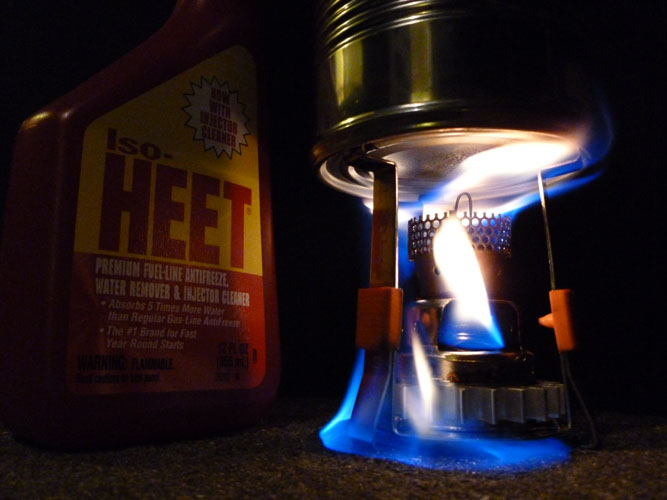
This overflow of alcohol in turn heated up the stove, which caused more fuel to boil over and further heat up the stove to create a positive feedback loop.
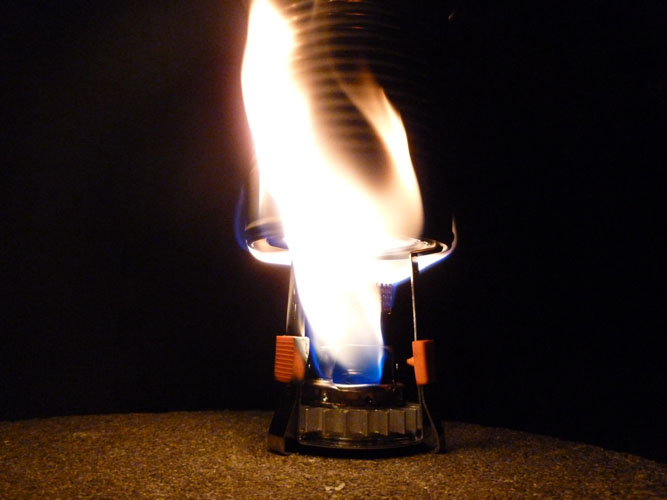
Soon the stove was engulfed in flames. I'm not sure to what extent this fuel is to blame for the uncontrollable flame and how much of the blame was due to over filling the stove. But either way, use of Iso-HEET with the G-Micro PSL is NOT recommended.
As you may have suspected, there was a lot of black soot up the bottom and side of the pot. The majority of this soot came off easily with a paper towel. The black burnt bottom took a bit of elbow grease to remove.
Looks like those silicone touch pads aren't fireproof.
70% Isopropanol Alcohol Fuel - Rubbing Alcohol - Without Nozzle Cap
Not a recommended fuel by manufacture.
Note: This fuel was never recommended by the manufacture of the G-Micro PSL. When I received the G-Micro from Gatt-Gen, it was marketed as both a Wax and an Alcohol (ethanol) Stove. After initial findings of this review were posted showing a stove and pot engulfed in flames from overfilling with alcohol, Gatt-Gen opted to change marketing for their stove to just being a solid Wax Stove. Liquid fuels such as alcohol present a spill hazard, can boil over and overheat a stove and can be very dangerous if added to a lit or hot stove.
Rubbing alcohol is available at many city corners around the world. It is cheap and can be used as an antiseptic. Being able to burn 70% alcohol means that you can use a very economical fuel which can be found in most parts of the world without too much fuss. The problem with rubbing alcohol is that it has at least 30% water in it and the alcohol is usually isopropanol. This makes it a challenge to burn cleanly in many alcohol stove setups and it won't work in certain alcohol stove designs. To complicated maters, the quality of rubbing alcohol in many places around the world is poor at best. That said, the G-Micro PSL's wick may allow you to use the G-Micro PSL like a spirit lamp and burn a number of fuels. And being able to use regular rubbing alcohol in the G-Micro PSL broadens its capabilities as a airline checkable travel stove since rubbing alcohol is available within walking distance from most hotels in the civilized world.
During this experiment, the 70% rubbing alcohol wasn't as enthusiastic to light up as other liquid fuels. The Nozzle Cap was removed and the wick extended to maximum height. The G-Micro PSL was held at an angle so that the weak alcohol flame could heat up the wick. In short time the stove could be placed on a flat surface and a pot placed on the stove. The wick was set so that the wire tip of the wick was just short of touching the pot, to prevent cooling of this wire.
The flame was weak and a windscreen would be needed anywhere where there is a breeze or draft. As the stove heated up, the flame stabilized and grew, but the flame still lacked the wind protection that the Nozzle Cap affords.
Since the wick is set high, you must keep the stove filled up enough so that the wick can draw fuel from the fuel reservoir. For this experiment, a small medical syringe was used to refill the G-Micro PSL.
NOTE: Refueling of a lit G-Micro PSL was preformed for experimental reasons and there is a real potential burn hazard whenever refueling a lit stove. Any fuel on the outside of your syringe, hands or work area can instantly ignite. There are any number of things which can happen during refueling such as failure of the syringe, tipping over of the stove or knocking over an open fuel bottle which can result in a catastrophic event. Therefore, refueling of a lit G-Micro PSL with liquid fuel in not recommended.
This configuration brought water to a rolling boil with less fuss than anticipated.
The bottom of the pot had soot, but much less than anticipated from burning rubbing alcohol with a wick. It was really just a film of brown soot which was easily wiped off.
70% Isopropanol Alcohol Fuel - Rubbing Alcohol
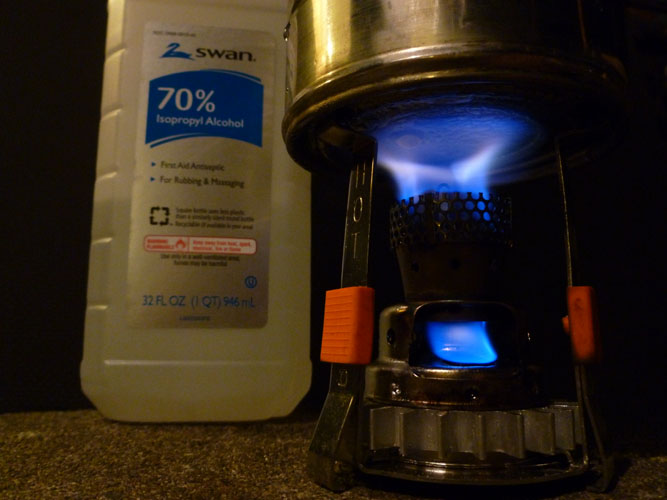
Not a recommended fuel for this stove.
Note: This fuel was never recommended by the manufacture of the G-Micro PSL. When I received the G-Micro from Gatt-Gen, it was marketed as both a Wax and an Alcohol (ethanol) Stove. After initial findings of this review were posted showing a stove and pot engulfed in flames from overfilling with alcohol, Gatt-Gen opted to change marketing for their stove to just being a solid Wax Stove. Liquid fuels such as alcohol present a spill hazard, can boil over and overheat a stove and can be very dangerous if added to a lit or hot stove.
70% Isopropyl Alcohol does work with the Nozzle Cap, but is very difficult to get going. Early on in this initial experiment, the wick was very difficult to light and the flame kept lifting off and dying. Once it got going, it seems to work, but appears delicate. A full tank of rubbing alcohol gets 2 cups of water hot enough for a good drink. You will need a good lighter or candle to get the flame going. Surprisingly, there was no soot on the bottom of the pot after using rubbing alcohol. Note the condensation on the bottom of the pot.
Follow up experiments with 70% Isopropyl Alcohol demonstrated easier lighting of the wick and a stronger flame.
91% Isopropanol Alcohol Fuel - Rubbing Alcohol
Note: This fuel was never recommended by the manufacture of the G-Micro PSL. When I received the G-Micro from Gatt-Gen, it was marketed as both a Wax and an Alcohol (ethanol) Stove. After initial findings of this review were posted showing a stove and pot engulfed in flames from overfilling with alcohol, Gatt-Gen opted to change marketing for their stove to just being a solid Wax Stove. Liquid fuels such as alcohol present a spill hazard, can boil over and overheat a stove and can be very dangerous if added to a lit or hot stove.
Isopropyl Alcohol in 91% is available in some drug stores, but is not as widely available as the 70% concentration.
Early experiments with an old bottle of 91% Isopropyl Alcohol proved disappointing when the stove was used with the Nozzle Cap. The extended wick would light and heat up, but the installation of the Nozzle Cap would extinguish the wick and lit gasses rising from the Nozzle Cap would lift off and self extinguish themselves.
Later experiments with a new bottle of 91% alcohol of a different brand was relatively easy to light. The Nozzle Cap was installed without issue and the gasified alcohol burned fine. The wick pulsated at first but later stopped pulsating after the stove heated up and the wick was lowered.
A reservoir filled with 15mL of this fuel got 2 cups of water hot enough for hot beverage.
There was no blackening of the pot.
99% Isopropanol Alcohol Fuel - Rubbing Alcohol
Note: This fuel was never recommended by the manufacture of the G-Micro PSL. When I received the G-Micro from Gatt-Gen, it was marketed as both a Wax and an Alcohol (ethanol) Stove. After initial findings of this review were posted showing a stove and pot engulfed in flames from overfilling with alcohol, Gatt-Gen opted to change marketing for their stove to just being a solid Wax Stove. Liquid fuels such as alcohol present a spill hazard, can boil over and overheat a stove and can be very dangerous if added to a lit or hot stove.
Isopropanol in 99% concentration isn't as widely available as as 70% strength, but its another potential fuel for the G-Micro PSL. The concern with 99% isopropanol is that it readily boils and can pack a punch, which can cause it to overheat the stove and create a fireball as seen above in the IsoHEET experiment.
Care was taken to not overfill the G-Micro PSL with more than 15mLs of full strength isopropanol. The wick easily took a flame and did not need any nursing. Once warm, the flames had some yellow tint to them and crawled slightly around the sides of the pot. Burn time was about 11 minutes. Water hot enough for hot drink.
This fuel produced minor glazing of the bottom of pot and minimal soot in one spot.
Note auxiliary wick in photo and lack of Nozzle Cap
Why not? It's a renewable fuel which is readily available in most parts of the world and likely is checkable at any airline.
Note: This fuel was never recommended by the manufacture of the G-Micro PSL.
Initial tests with canola oil were very disappointing. It was difficult and almost impossible to light the wick on the the G-Micro PSL. Even use of an auxiliary wick in the filler hole only got the G-Micro PSL's top portion of the wick to burn.
Use of an auxiliary wick made from rolled up paper towel wrapped around the stock G-Micro PSL's wick with the paper towel wick ends dipped in the filler hole allowed for a reasonable sized yellow flame without the Nozzle Cap. The stock G-Micro PSL wick can also be replaced with a wick made from cotton or wood (paper towel) for a make due plant oil burner, but similar results can be accomplished with an empty tuna can and a bit of ingenuity.
Liquid Paraffin Fuel - Lamp Fuel
Not a recommended fuel for this stove fuel by manufacturer.
Note: This fuel was never recommended by the manufacture of the G-Micro PSL. When I received the G-Micro from Gatt-Gen, it was marketed as both a Wax and an Alcohol (ethanol) Stove. After initial findings of this review were posted showing a stove and pot engulfed in flames from overfilling with alcohol, Gatt-Gen opted to change marketing for their stove to just being a solid Wax Stove. Liquid fuels such as alcohol present a spill hazard, can boil over and overheat a stove and can be very dangerous if added to a lit or hot stove.
Lamp fuel is generally considered to be not explosive and isn't that different from solid paraffin, expect for the whole liquid at room temperature trait and the size and configuration of the hydrocarbon molecules.
Note: The following is a report of an experiment and not a recommendation to disregard the manufacture's warning to not use fuels other than 145F Wax. There are many scenarios where Lamp Fuel could be very dangerous. The following is provided for educational purposes only.
Lamp fuel quickly saturated the wick after lamp fuel was added to the stove. The wet wick readily took the flame from the lighter. The Nozzle Cap was slowly lowered over the wick. It is possible to auto ignite the gasified fuel with the wick flame, but it readily lights with a quick flame from the lighter without issue or delay.
At first the flame was blue and medium in size. The size of the flame grew after the stove warmed up and some yellow flames occasionally danced around the sides of the pot. The flames seemed to be motivated by the minimal wind encountered during these experiments. Water was easily heated up and came to a rolling boil with plenty of fuel left in the stove.
Refilling the stove with a syringe was performed without flare-up or explosion. The syringe plunger gave a lot of resistance and didn't seem to like the lamp fuel. Retracting the syringe plunger too fast resulted in the plastic plunger stem separating from the rubber plunger tip due to the increased rubber tip to syringe wall friction.
NOTE: Refueling of a lit G-Micro PSL was preformed for experimental reasons and there is a real potential burn hazard whenever refueling a lit stove. Any fuel on the outside of your syringe, hands or work area can instantly ignite. There are any number of things which can happen during refueling such as failure of the syringe, tipping over of the stove or knocking over an open fuel bottle which can result in a catastrophic event. Therefore, refueling of a lit G-Micro PSL with liquid fuel in not recommended.
In regards to refueling the G-Micro PSL with Liquid Paraffin Candle and Lamp Liquid - it is good that the stove holds 15ccs of fuel. This is more fuel than is needed to bring 2 cups of cold water to a rolling boil. So if you keep your cooking/boiling needs down to a reasonable level, refueling will only need to be performed prior to lighting your G-Micro PSL.
Pot blackening was significant but isolated to the bottom of the pot. This blackening came in the form of a hard mico-thin coating and covered more of the bottom of the pot than was encountered during the tealight wax experiment.
It seems that the stove wick is too tall for liquid paraffin. Performance of lamp oil may be improved with a shorter wick. The stove also has what appears to be heat exchangers within the stove for melting wax. These are unnecessary for liquid paraffin and likely cause a loss of fuel through overheating and vaporization in the fuel chamber.
That said, this fuel actually performed nicely. Odor was very similar to paraffin wax burning but without the dramatic smoldering phase experience when the G-Micro PSL is fueled by wax and is extinguished.
Not a recommended fuel for this stove fuel by manufacturer.
Note: The following is a report of an experiment and not a recommendation to disregard the manufacture's warning to not use fuels other than 145F Wax. There are many scenarios where kerosene or what is thought to be kerosene could be very dangerous. The following is provided for educational purposes only.
Kerosene is generally considered non-explosive and is readily available throughout the world. It has a distinctive and unappealing odor when stored and a similar odor when burned. During these experiments, the G-Micro PSL's wick lit instantly without the need to turn the stove sideways. It produced a lot of yellow flame which travels up the side of the pot.
A pot with 2 cups of water was brought to a rolling boil in short time with plenty of burn time and fuel to spare.
Refueling with a syringe while the stove was lit was uneventful. Due note that the syringe used pretty much occluded the filler hole, which limited the amount of flame coming out of it. This is good as long as you don't get the syringe stuck. A purpose modified syringe with protruding metal tip and flat area to cover the filler hole would work better if kerosene was something that would be used frequently in the G-Micro PSL.
NOTE: Refueling of a lit G-Micro PSL was preformed for experimental reasons and there is a real potential burn hazard whenever refueling a lit stove. Any fuel on the outside of your syringe, hands or work area can instantly ignite. There are any number of things which can happen during refueling such as failure of the syringe, tipping over of the stove or knocking over an open fuel bottle which can result in a catastrophic event. Therefore, refueling of a lit G-Micro PSL with liquid fuel in not recommended. A flare-up of kerosene is much more hazardous than a flare-up of alcohol and can cause significant burns. Refueling a lit stove with kerosene should not be performed by the general public.
In regards to refueling the G-Micro PSL with kerosene - it is good that the stove holds 15ccs of fuel. This is more than is needed to bring 2 cups of cold water to a rolling boil. So if you keep your cooking/boiling needs down to a reasonable level, refueling will only need to be performed prior to lighting your G-Micro PSL.
Blackening of the pot was significant. Both the bottom and most of the side of the pot was black.
A can bottom after burning 15mL of Lamp Fuel is shown on the left in the image above, while the bottom of a can after burning 15mL of Kerosene is shown on the right. Blackening was significanly more prominent more with Kerosene, more so than the image here suggests.
A can side after burning 15mL of Lamp Fuel is shown on the left in the image above, while the side of a can after burning 15mL of Kerosene is shown on the right. Blackening was significant with Kerosene and almost nonexistent with Lamp Fuel. The blackening on the side of the can was mostly soot. The soot came off easily with soap and water but a more "durable" stain was still present on the lower side of the pot. This came off with an abrasive pad.
The stove smelled like kerosene after all fuel was used.
This fuel actually worked fine if you don't mind the horrible smell of incomplete burning kerosene or the blackening of your pot.
Note: Using white gas in the G-Micro PSL is a bad idea. Not only is this fuel potentially explosive, it also doesn't work well at all with the G-Micro PSL. This fuel may even burn hot enough to damage the G-Micro PSL.
Depending on stove and air temperature, White Gas can start off with a nice hot flame when used in the G-Micro PSL. It seems like a reasonable fuel early on after igniting the stove.
The flame from the filler hole seems to heat up the stove quickly leading to an increase in flame form both the Nozzle Cap and the filler hole. Soon after ignition, a good amount of flame will rise up from the filler hole.
Flare ups with White Gas can be pretty exciting, especially when you are taking photos at night with the camera inches from the stove. Leaving a bottle of White Gas next to a lit stove as shown in the photos above is also a bad idea. Also note that the Touch Pads have been removed in the image above as they were all burned during earlier tests with White Gas.
Refined White Gas should be avoided in the G-Micro PSL. It burns very hot and is extremely explosive. The G-Micro PSL has an internal heat exchanger designed to heat up and melt solid wax. This same heat exchanger will bring high volatile fuels such as white gas to a boil in no time.
Two initial runs of Coleman White Gas were performed. The first test was conducted with 10ccs of fuel and the second with 15ccs of fuel. The stove lit easily with the nozzle cap already installed and the G-Micro PSL level on the ground. In short time, the G-Micro PSL turned into a ball of yellow flame which engulfed the entire stove and most of the pot. The fuel burned up at a rapid pace. Water in the test pot was warm to touch after the fuel was used up and the water failed to reach the boiling point after use of all the fuel tested.
Subsequent runs at night with a frozen stove seem to allow for better control of heat output early on. This suggests that the G-Micro PSL is very sensitive to warm temperature when using White Gas.
The G-Micro PSL produced an audible crackling when using White Gas. There is what appears to be silicone sealant in the bottom of the G-Micro PSL and this has the potential of being damaged or even igniting once the stove gets hot enough. Refueling with White Gas with the stove lit was not tested as adding White Gas to a fire ball did not seem like a good idea.
Like Kerosene and Liquid Candle, White Gas doesn't agree with the rubber plunger of the test syringe.
Pot blackening was severe and covered the bottom and side of the pot.
Note: Using automotive gasoline in the G-Micro PSL is dangerous.
Automotive gasoline is extremely explosive and poisonous when burned. Beyond the toxicity of the fuel itself, the additives in the fuel for automotive use is extremely toxic in both liquid form and when burned. The G-Micro PSL has an internal heat exchanger designed to heat up and melt solid wax. This same heat exchanger will bring automotive gasoline to dangerously high temperatures in short time.
Automotive gasoline is likely to burn too hot and burn up too fast like White Gas. It may also leave contaminants in the wick. This fuel was not tested.
Liquid Fuel
The G-Micro PSL is more or less a fancy wick with burn chamber above the wick. This design allows the G-Micro PSL to burn just about any flammable liquid fuel. This has been demonstrated by the quick experiments above.
It is important to note that there are several hazards associated with burning liquid fuel in the G-Micro PSL.
Liquid Fuel Hazards:
Spill hazard - spilled fuel when filling the G-Micro PSL or afterwards while the stove is lit can create a significant fire hazard.
Overfill hazard - if the G-Micro PSL is filled with more than 15ccs of liquid fuel, the fuel may boil over, ignite and overheat the G-Micro PSL
Hot Stove hazard - if you burn wax in the G-Micro PSL, you must wait for the stove to be cool before filling with liquid fuel. Even with the flame extinguished, the G-Micro can still be hot enough after burning wax (or other petroleum based fuel) to boil alcohol and create a significant flare up.
Refilling lit stove hazard - there are so many things that can go wrong when refueling the G-Micro PSL when lit. This practice CAN NOT be recommended for the general public.
Melted Wax and Alcohol hazard - adding alcohol to a lit G-Micro PSL with wax in it will cause a significant flare-up. This can burn anything which might be over the stove during refilling, such as any equipment, your hand or your face. The G-Micro PSL must be free of any wax before using liquid fuel. If you burn your G-Micro PSL with your wick not completely bottomed out, you will leave wax in the fuel reservoir even after the stove "burns out".
Explosion hazard - unlike solid wax, liquid fuel can and will explode under just the right conditions.
Child hazard - this stove is not for children. Children are unpredictable and are prone to serious burns. The G-Micro PSL should not be operated by children when using liquid or wax fuel.
Overheating hazard - there are a number of ways to overheat the G-Micro PSL. Once you get the stove hot enough, your liquid fuel will begin to boil in the Fuel Reservoir, which will increase the amount of fuel burned from the filler hole, which in turn heats up the stove. This creates a positive feedback loop which keeps the stove overheated. This can result in a burn rate greater than desired or even a dangerous fireball.
It's understandable that Gatt-Gen long longer supports the use of liquid fuel for the G-Micro PSL.
Pot Supports
The G-Micro PSL pot supports and able to support pots from beverage can size to much larger sized pots. It held up a pot made from a 19oz soup can nicely as the three pot supports fit perfectly with the recessed ring on the can bottom. The supports seem sturdy enough and can support a wide pot or pan if needed.
Lantern Mode
Raymond Gatt sent a glass lantern globe to try out. The pot supports on the G-Micro PSL are able to support this glass globe at various heights. The globe protects the flame from wind and seems to intensify the luminosity of the flame.
Personal note: I don't like the idea of packing a glass lantern globe in a backpack, but this opens up some possibilities which should be consider later. Instead of just sleeping after it's dark or talking in the dark, a lantern allows for continuous light for reading, projects, mood lighting and keeping the boogie man at bay. A tealight lantern can do something similar, but the G-Micro PSL throws out considerably more than any candle.
This lantern mode may be nice in a remote cabin.
Wick Break-In
Raymond Gatt mentions that the G-Micro wick performs better after it is broken in. It was originally assumed that this break in occurs after the wick is initially saturated with wax and burned for the first time. Interesting enough, after using the wick many times for various experiments, it became noticeably easier to light the wick. Part of this is from learning how to actually load, prime and light the wick. But part seems to have something to do with the wick itself, as it seems to more easily absorb melted wax and light up after "break in".
Pot Blackening
For those used to gas or alcohol stoves, blackening of the pot may be an issue for you when using the G-Micro PSL.
In the image above, you can see how the deposits left on the bottom of two cans after beeswax and Wax Stix were used. This isn't just "soot" that you sometimes see with incomplete burning in various stoves. This is actually a coating of unburned wax. This is particularly a problem when using the supplied Wax Stix, which was produced a notably thick layer of wax which leaves a greasy black mark on your fingers if you run your finger across the bottom of the pot. The wax residue wasn't as bad when regular candle wax was used or when beeswax was used compared to Wax Stix.
It is possible that these experiments were performed with a bad batch of wax from Gatt-Gen. Tests with Gulf Wax suggest that the significant amount of pot blackening and wax build up on the pot encountered with Wax Stix is a fuel issue and not a stove flaw.
This waxy build up comes off with some scrubbing with an abrasive pad.
Blackening from Liquid Candle Fuel (above left) is less than what you would get from most paraffin waxes with the G-Micro PSL, while kerosene (above right) covered the sides and bottom of the pot with black soot.
G-Micro PSL Efficiency Testing
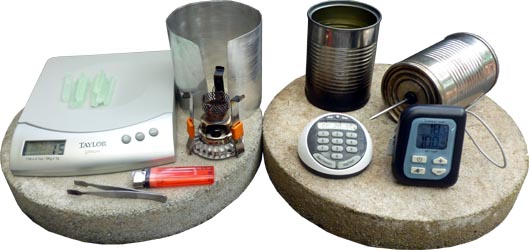
The G-Micro PSL was tested for boil times and fuel use. All testing was performed outside with a windscreen and a clean soup can used as a pot. The windscreen was made from aluminum roof flashing and was trimmed so that it fit inside the soup can pot when rolled up. An gap in the windscreen was left open to allow for refueling of wax. This windscreen design was selected to simulate a practical windscreen which may be carried by a hiker.
The stove and fuel where measured with a digital kitchen scale before and after the test to determine fuel used. The tweezers, lighter, windscreen and pot were not part of the measured weight.
A pot lid was made from another empty soup can. A hole wad drilled in the center of the bottom of this "lid" and a rubber grommet was used to line the hole. The probe from a digital food thermometer was wrapped with electrical tape at the center of the probe so that it this would hold the probe in position in the rubber grommet, to seal the lid from water vapors and to insulate the thermometer probe from the lid.
Cold tap water was used and 2 cups were added to an empty soup can for each boil test run. After water was boiled, the can was empted, rinsed and filled with 2 cups of cold tap water. Wax residual was not removed from the soup can between each use.
Time was started after the soup can filled with water was placed on the G-Micro PSL. Time was stopped when the thermometer read 100ºC. Boiling sounds could be heard about a minute or two prior to hitting the 100ºC mark.
The G-Micro PSL's flame was blown out after water reached the 100ºC mark. After the stove stopped smoking, it was placed in a freezer to speed up cool off periods between test runs.
Wax Test Data:
| Run | Start # Stix |
End # Stix |
Δ # Stix |
Start Wt (gm) |
End Wt (gm) |
Δ Wt (gm) |
Start Temp (ºC) |
End Temp (ºC) |
Δ Temp (ºC) |
Outside Temp (ºC) |
Time | Notes |
| 1 | 12 | 1.3 | 10.7 | 143 | 135 | 8 | 16.3 | 100.0 | 83.7 | 16.5 | 19:05 | Dry wick; empty stove |
| 2 | 12 | 8 | 4 | 155 | 147 | 8 | 16.0 | 100.0 | 84.0 | 16.8 | 20:47 | Stove left in freezer too long; pot blackened |
| 3 | 12 | 8 | 4 | 154 | 146 | 8 | 16.7 | 100.0 | 83.3 | 16.7 | 19:52 | Watching movie - ran past boil by ??? Time stopped at 19:52 |
| 4 | 12 | 8 | 4 | 154 | 146 | 8 | 17.0 | 100.0 | 83.0 | 18.0 | 20:57 | |
| 5 | 12 | 8 | 4 | 153 | 146 | 7 | 17.1 | 100.0 | 82.9 | 17.3 | 20:39 | Pot well blacked at end of tests |
Note: A full size windscreen and a wider based aluminum pot, such as a grease pot, would likely result in more favorable boil times and fuel efficiency.
After 5 runs of the G-Micro with a clean pot, the bottom of the pot was covered with somewhat greasy black wax. Some of this would easily blacken hands and gear the pot may comes in contact with. It washes easily off of hands with soap and water, but removing black from the pot requires a bit of scrubbing.
Three test runs were performed with denatured alcohol to get a rough idea of fuel performance with this fuel.
Alcohol Test Data:
| Run | mL Alcohol |
Approximate
Weigth (gm) |
Start Temp (ºC) |
End Temp (ºC) |
Δ Temp (ºC) |
Outside Temp (ºC) |
Time
Total |
Time
to Boil |
Notes |
| 1 | 15 | 12 | 10.2 | 79.1 | 68.9 | 10.3 | 15:14 | ||
| 2 | 20 | 16 | 14.0 | 100.8 | 86.8 | 12.0 | 18:00 | 16:33 | Requires 5cc refuel at the 10 minute mark |
| 3 | 20 | 16 | 11.0 | 100.8 | 89.8 | 13.0 | 19:20 | 18:29 | Requires 5cc refuel at the 10 minute mark |
When using denatured alcohol, the G-Micro PSL gets 2 cups of water to a near boil, but must be refueled to get 2 cups of water to a full boil. There are notable hazards with refueling a lit or hot stove with liquid fuel and this practice is not advisable for the general public.
G-Micro PSL Cooking System Setup
The G-Micro PSL needs a few times to create a complete and functional cooking system.
You need the following components for your G-Micro PSL cook system:
G-Micro PSL stove
Small pot or mug. A Soup Can works perfectly
Windscreen. A rolled up rectangular piece of aluminum sheet works perfectly
Fuel
Fuel bottle with tapered tip if using liquid fuel - otherwise you will need a syringe to measure and deliver fuel into the stove
Chamois leather (shammy) to hold hot pot and to keep the G-Micro PSL from rattling around in the pot
Lighter
Tealight - use to prime wick with wax and to help light new stubborn wicks.
Plastic bag or pot cozy if concerned about blackening of pot staining your pack
Small jar lid to protect surface under stove if you are using odd shaped pieces of wax and are sloppy
Analysis and Discussion
The G-Micro PSL and related technology has great potential. Gatt-Gen is still new and it is likely that significant improvements in this technology in the years to come. As is, it is a reasonable option for those needing a stove and fuel with an indefinite shelf life or fuel which can be placed in check in baggage.
Overall Quality
The G-Micro PSL appears to be well made. The majority of the stove and accessories are made from stainless steel and seems durable enough to withstand significant abuse. The one exception are the tweezers. These are low quality tweezers as tweezers go, but more than adequate for their task of moving the wick up and down, lifting the stove and adjusting the Nozzle Cap. Raymond Gatt points out that that the tested G-Micro PSL is an early version and that his stoves now come with a better quality pair of tweezers. That said - the tweezers are fine and easy to reshape to your own needs. Just don't expect to use them to pull out a sliver or an eyebrow hair.
Packability
The G-Micro PSL system is light weight and compact enough to allow it to be easily packed and stored. You can easily pack the stove in a mug or small pot. The wax fuel is solid, so you can throw it into a ziplock bag stored in your mug or elsewhere.
This is one of the only stove options available which allows you to check in both the stove and fuel at the airport. This allows you the ability to use your stove immediately after arriving at your destination without needing to go on a hunt for fuel. It also likely doesn't need to be cleaned prior to checking in at the airport like a pressurized petrol stove would (unless you use a liquid petrol fuel in this stove). This makes it possible for many types of travelers to now travel with a usable stove without the fuss and delay of trying to track down fuel before heading out to their final destination.
Raymond Gatt provided an example of a coffee drinker who travels around and tries out coffee in the fields of Central America. For him, the G-Micro PSL stove can be easily packed and used in the coffee fields or in many of the homes which tend to be well ventilated. There is no need to carry stinky gasoline and a heavy multifuel stove which needs to be odor free before getting it back on a plane. Other fuels (i.e. canister fuel, denatured alcohol) are often difficult to locate and spending valuable time looking for fuel while on holiday is often undesirable.
Weight
For those wishing to minimize their gear weight, it's good that Raymond Gatt decided on a smaller stove to market. It's size is sufficient enough for solo use without any significant extra bulk.
G-Micro PSL Component Weights
| Component(s) | oz | gm |
| Main Stove | 1.3 | 36 |
| Wick | 0.3 | 9 |
| Nozzle Cap | 0.6 | 17 |
| Stand | 1.8 | 50 |
| Heat Defuser Ring | 0.3 | 10 |
| Tweezers | 0.5 | 13 |
| Assembled Stove | 4.3 | 122 |
| Assembled Stove with Tweezers | 4.8 | 134 |
| Assembled Stove minus Heat Ring | 3.9 | 112 |
| Assembled Stove with Tweezers and minus Heat Ring | 4.4 | 125 |
Beyond what comes with the G-Micro PSL, you will also need a pot or mug, a windscreen and if you are using liquid fuel, you will need a bottle with a tapered tip or syringe to add fuel to the tiny fuel port.
It is possible to operate the G-Micro PSL without tweezers, but the tweezers make it so much easier to add solid wax fuel and adjust the wick height and Nozzle Cap position. They will help prevent you from burning your fingers. In alcohol mode, with good alcohol, the G-Micro PSL can be used without the tweezers, but you'll need a syringe or other means of getting fuel into the fuel port.
In regards to the heat ring, I'm not sure what it really does for stove performance. Raymond Gatt explains that the cooling fins are needed in hot weather above 90ºF.
Minim Stove Weight Comparisons
| Stove | Stove Weight | Fuel Canister | Canister Weight | Total |
| G-Micro PSL minus ring and tweezers | 3.9oz(112g) | 0 for wax/plastic bottle for alcohol | 0/minimal | 3.9oz(112g) |
| MSR SimmerLite Stove (Petrol ) | 8.5oz | 11 fl oz MSR bottle | 2.8oz | 11.3oz |
| Monatauk Gnat Gnat (Gas) | 1.6oz | 110gm SnowPeak canister (empty) | 3.05oz | 4.65oz |
| Vargo Titanium Hexagon Wood Stove | 4.1oz (116g) | Maybe film canister for fire starter | 0+ | 4.1 oz (116 g) |
Fuel Storage
Wax has an indefinite shelf life. And unlike other combustible fuels, wax doesn't need a metal container for storage or any special environmental constraints such as low humidity or a narrow temperature range. This makes it ideal for storage or even stockpiling for emergencies. It can be safely stored in your vehicle or basement for future use.
Although not endorsed by Gatt-Gen, several liquid fuels can be used with the G-Micro PSL. Each will have its own special requirements for long term storage.
Heat Output
The heat output of the G-Micro PSL is low compared to most all stoves on the market, so it's not an option for those looking for a high output stove to melt snow or cook for a large group. But if you are accustomed to low output of solid fuel tablets or low performance alcohol stoves, the G-Micro PSL should be sufficient to boil up 2 cups of water for those not in a hurry. It took around 20 minutes to boil 2 cups of water when using Wax Stix.
Light Output
This stove can be used like a kerosene lamp with the addition of a lamp globe or "as is" if you don't have any wind. This is useful for those who may need a lamp in a cave or under a tarp at night. This is one potential benefit that the G-Micro PSL has over most other stove options.
Exhaust Emissions
This is a potential significant problem for many. This stove does produce a good amount of emissions. The emissions smell like a room full of paraffin wax candles burning all at once, which is comparable to what this stove is basically doing. Raymond Gatt sent two articles claiming that candle emissions are safe (1, 2). It is important to note that these articles and research were funded by the big global candle making associations so the authors of these articles have a notable conflict of interest and likely result bias. I was unable to find any hard evidence that gasified wax is harmful, but would not personally use this stove indoors to burn wax. Keep in mind that I also don't burn candles indoors. Raymond Gatt says that he has used this indoors without issue.
It appears that different waxes perform differently with the G-Micro PSL stove. Beeswax seemed to burn the cleanest. Economy tea light wax produced more emissions and pot blackening than beeswax. Gulf Wax produced less pot blackening that Parowax and both produced less pot blackening than Gatt-Gen Wax Stix. The supplied Wax Stix produced the largest amounts of pot blackening of the waxes tested, especially when the wick was set to maximum height and during the smoldering phase after extinguishing the flame. The Wax Stix emissions may be due to the quality of the wax they used, the green dye in the wax or some sort of contaminant introduced during the manufacturing process of making "Stix".
Compared to Hexamine and Trioxane, the fumes are probably ok and many would actually find this candle smell pleasant. When used outdoors with the wick set at the proper height, odor is noticeable, but not noxious in any way.
Liquid Candle Fuel performed better than expected with burning emissions similar to tea light candle wax. The Liquid Candle Fuel didn't seem to have a noticeable smoldering phase as seen when a wax flame is extinguished. This is important as the majority of emissions from using wax in the G-Micro PSL occurred during the smoldering phase where you can see smoke and wax vapors being pumped out of the stove.
Kerosene has a characteristic smell when burned and even when a bottle of kerosene is opened. Burning of Kerosene produced a good amount of emissions and covered the bottom and side of the pot with black soot. Kerosene is not a recommended fuel for the the G-Micro PSL but does work surprisingly well.
I feel that emissions and odor when burning wax or petrol fuels is what limits this stove's utility as an indoor travel stove. If you burn these fuels in a hotel room, you may alert the manager that you are doing something strange. Plus, inhaling large amounts of unburned wax or petrol fuel is likely not good for one's health.
Pot Blackening
Pot staining can be an issue for some. The occurrence and magnitude of pot staining is dependant on what type of fuel you are using and to a lesser degree, where you set the G-Micro PSL's wick height. Wind may also play a role in incomplete combustion and increased soot formation.
Denatured alcohol, methanol and even 70% isopropanol rubbing alcohol failed to cause pot blackening when used with the G-Micro PSL.
Beeswax left brown wax deposits on the bottom of the stove. Economy tealight wax left black wax on the bottom of the pot. Supplied Paraffin Wax Stix covered the bottom of the pot with a layer of black greasy wax and left soot on the bottom side of the pot.
Liquid Candle Fuel stained the bottom of the pot similar but to a slightly greater degree than tealight wax. Kerosene severely blackened the bottom and sides of the pot. Much of the blackening from kerosene was soot which will easily blacken your hands or pack once they come in contact with the pot.
Ease of Use
Compared to a gas stove, solid fuel and alcohol stoves, this stove is complicated if not difficult to use.
It's really not that bad once you figure out how to work it, but there are a lot of steps and a learning curve. If you can't get an Optimus multifuel stove to light, and there are many who can't, this stove is not for you. If you are in a hurry to cook, this stove is also not for you.
Denatured alcohol, HEET methanol, Liquid Candle Fuel and Kerosene were very easy to start.
Beeswax and 70% Rubbing Alcohol were very difficult at times to get burning.
Practicality of Fuel
Wax Stix are only commercially made by Gatt-Gen. This makes fuel procurement difficult in remote areas. Wax from candles and paraffin blocks can be used in the G-Micro PSL, but these must be cut up into small enough pieces to fill the small filler hole in the Fuel Reservoir. This is somewhat time consuming and can be messy. "Wax Stix" can cast for use later, but this takes a considerable amount of effort.
If the stove is to solely used as a survival stove, then cutting up blocks of wax is reasonable when the alternative is going without hot food or light. If the G-Micro PSL is to be used as an ultralight long distance cook system, then casting enough wax sticks prior to the trip may be worth the effort since the G-Micro PSL allows for a very light weight stove option. But for most trekkers, the need to cut up small bits of wax may be too painful in the day and age of Piezo ignition stoves.
Time to Boil
Realistically, the time needed to boil water isn't as important as all the marketing makes it out to be unless your goal is to melt gallons of water and don't want to spend all day doing it of if you are cooking for a group of people.
The G-Micro PSL was tested outside with some wind, cold air, cold water and a thermometer. This test environment is likely a bit harsher than the idealized test environments used by the big stove manufactures. But even when taking that into consideration, the G-Micro PSL is exceptionally slow to bring 2 cups of water to a boil.
| Stove | Fuel | Amount of Water | Time to Boil |
| G-Micro PSL | Wax | 2 cups (~475mL) | 20.2 minutes |
| G-Micro PSL | Alcohol | 2 cups (~475mL) | 17.5 minutes |
| MSR XGK (Petrol) | Kerosene | 1 Liter | 2.8 minutes |
| MSR Reactor | Gas | 1 Liter | 3 minutes |
Note: After reading this review, Raymod Gatt of GattGen responded with:
On the subject of 2 cup boil times; You seem to be getting 20 min boil times. I on the other hand get a boil in 12min +/_ with wax. To do this I start with about 68f water in a MSR Titan Pot with tight fitting lid having a small hole in the lid to hold a temperature logger probe. I carry out the testing indoors with no wind at about 70F ambient. 20 min seems a bit long to me but maybe it's what happens when a, low tech, tin soup can is used instead of a high tech Titanium Pot. Maybe fabricating a tight fitting lid will improve the soup can boil times. There is a sweet spot wick height setting which gives max boil times and minimal soot / wax deposits on the pot. Increasing wick height does not quicken the boil but does increase odor and soot. Every stove will be a little different and finding the spot is like adjusting the fuel jet screw on an English petrol engine ... meaning painfully small adjustments are required.
It is entirely possible and likely that the height of the wick will make a difference in regards to cook times and that the tests above were performed with a less than optimal wick height. Further tests would be needed to confirm this.
Fuel Efficiency and True Weight
An often overlooked factor in a stove system is how fuel efficient it is. "Efficiency" in this sense means how many units of weight of fuel you need per day. When you factor in how much fuel you need per day for a long trip, you may be surprised at what a complete cooking system with fuel weighs over the course of your trip. A light weight inefficient system can easily weight more than a heavier but more efficient stove or a heavier wood stove when you factor in the average weight of fuel.
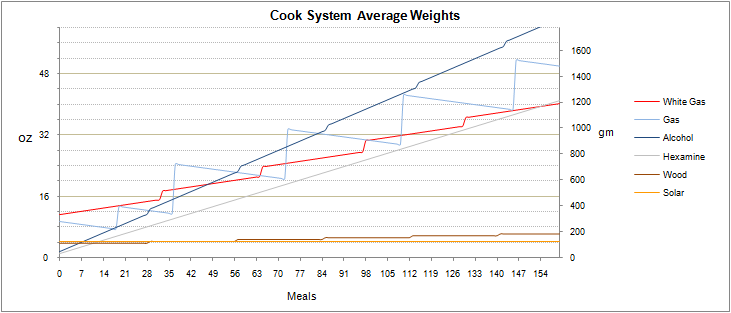
Data plotted out to 160 meals (1 meal = 2 cups boiled water) to demonstrate general trends
See Stove Choices - Efficiency
This busy graph shows some interesting trends with various cook systems. For short trips, low output cook systems such as alcohol and hexamine fueled system are by far the lightest overall systems you can have. But as trips get longer or as your party or cooking needs grow, both gas and petrol cook systems become lighter compared to alcohol. The zigzag lines are confusing as liquid fuels require additional weight for fuel bottles in incremental levels. The average weight of a gas stove system actually decreases over time as more cooking means that you are carrying a lighter canister at the end of the trip. This chart also doesn't take into account, temperature affects on various fuels, or special needs or practicality.
How efficient is the G-Micro PSL?
Manufacture's specs:
Paraffin wax consumption 26g/hr 0.91oz/hr
Boil cold water (Max 16oz [2 cups, 462mL]) at less than 1 min per oz.
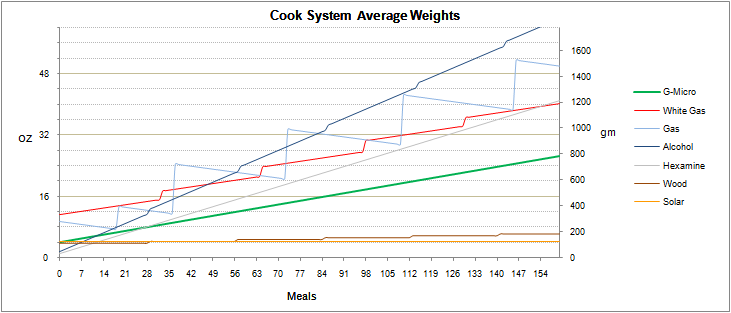
Average Packed Weight of G-Micro PSL based on experimental data
The published G-Micro PSL Specs suggest that you will need less than 16 minutes of burn time to boil 16 US fl oz of cold water. At a wax consumption rate of 26g/hr, you would need 26g/60min x 16min = 6.9grams (~1/4oz) of wax. If this is close to accurate, that's pretty impressive, especially if the G-Micro PSL weighs less than 4 oz.
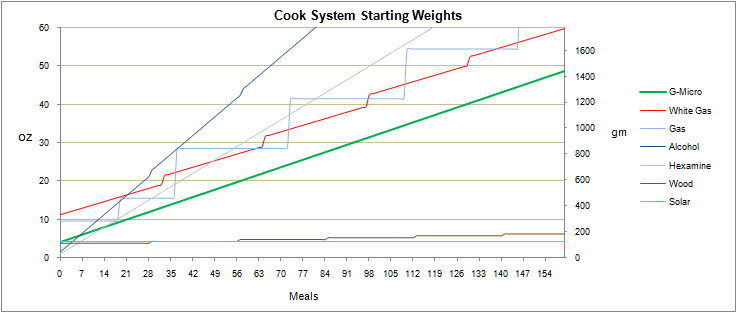
Packed Weight of G-Micro PSL at beginning of trip based on experimental data
Actual testing of the G-Micro PSL demonstrated that just under 8 grams (~0.28oz) of Gatt-Gen Wax Stix were needed to bring 16 US fl oz of cold water to a real boil. That's pretty impressive and makes the G-Micro one of the lightest stove systems around.
Unique Issues
1. The flame is very fragile and prone to blow out even in light wind. You must take measures to protect the flame when first lighting and then use a windscreen to protect your flame.
2. Small fuel port. The fuel port consists of a very small hole in the top of the Fuel Reservoir. It's the perfect size for the provided wax fuel sticks, but can prove a challenge once you run out of this specially made fuel. With a small amount of effort, you can take a knife to a candle stick or wax bar and make shavings, chunks or sticks just the right size for the filler hole. You can also pre cut or pre cast small sticks, balls or cubes for use later on. For liquid fuel, you will need a syringe or special fuel bottle with a "squirting" end.
3. Invisible flame in daylight. It can be difficult to light stove the daylight as it is hard to tell if the wick is actually burning. You need to shade your stove to see the flame or trust that when the there isn't smoke coming from the Nozzle Cap it's because the stove is lit.
4. Fuel quality and compatibility. Some wax works better than other was in the G-Micro PSL. I believe that the supplied Wax Stix are defective. They did start up and burned "fine" but produced a lot of emissions compared to other wax tested. Economy candle wax and Gulf Wax burned notably "cleaner" than Wax Stix. Beeswax was difficult to light, but it is important to note that tests on beeswax were performed prior to wick break-in.
Conclusion
Disclosure Statement/Conflict of Interests
I was provided a two G-Micro PSL stoves, an extra wick, a globe, a prototype G-Micro mug with lid and a box of wax free of charge for this review. I made it clear that if I published a review, it would be honest and that I would let Raymond Gatt know if his product was flawed. I have no financial ties with Gatt-Gen and did not receive any monetary or other compensation for this review.
Summary of G-Micro PSL Personal Stove and Light
The G-Micro PSL is not a bad little stove, depending on what you are looking for. It is a low output performer capable of boiling a sufficient amount water for a solo hiker, which is fine and sometimes even preferred by those looking for more energy efficient or simple systems. The physical characteristics of wax makes it ideal for storage and allows you to pack both the stove and its fuel in check in baggage at the airport, which allows you to have a working stove shortly after your feet are back on the ground. So for various survivalists and air travelers alike, this stove has great potential utility.
Per the manufacture's stats, this is potentially one of the most efficient systems available of outdoorsman without match. Independent tests showed that the G-Micro required just shy of 8 grams of Gatt-Gen Wax Stix to boil a pint of water. This makes the G-Micro the lightest weight packed cook system on a trip requiring more than 14 pints (a pint is 2 cups or around a half liter) of water to be boiled when compared to hexamine and a very minimalist setup.
In regards to cook times, the G-Micro PSL is painfully slow. The G-Micro PSL requires around 20 minutes to bring two cups of cold water to a real boil. This is one of the longest boil times around which makes it a poor choice for melting large quantities of water or cooking for more than one person. Raymond Gatt of GattGen reports times of 12 minute boil times when an optimum wick height is used. This is more reasonable than 20 minutes, but is still slow for most and this hasn't been confirmed.
This stove and fuel will fit in a small mug or empty soup can, which can be easily packed in a small pouch on a tactical vest or ruck. This allows hikers, international backers and military personnel alike a personal and durable waterproof stove option which can heat up a cup of coffee or illuminate a small well ventilated room.
Outside of its intended design of use, this stove is able to burn liquid paraffin. It's not the perfect setup for this fuel and it does burn somewhat "dirty". Still, this stove allows for a very light petrol fuel option in cold weather to heat up 2 cups (half liter) of water for food or drink at a time. Refilling with liquid petrol fuels is unnecessary as the G-Micro PSL will hold more fuel than is needed to boil 2 cups (half liter) of water.
In regards to using alcohol with the G-Micro PSL, it runs fine on denatured alcohol and methanol. While the stove is in use, refueling is easy with a syringe or special bottle, which is pretty exciting in itself, although this caries a potential risk of burns if performed by the general population. The G-Micro PSL is heavy for an alcohol stove when compared to the many ultra-lightweight homemade creations out there, but is still lightweight when compared to other commercial backpacking stoves, including the the purpose made Trangia Westwind alcohol burning system.
For its intended use as a wax gasifier, this little stove is impressive compared to the dirty and sometimes dangerous homemade survival wax stoves used by many. There is a lot of fiddle factor with this stove and a learning curve to use. Wax fuel will need to be casted to the proper size or cut up to fit the tiny filler hole on the G-Micro PSL. Economy tealight candles seem to be an ideal fuel as they are easy to pack and can be used without the stove for light, heat and limited cooking. The supplied Wax Stix were the perfect size for use with the G-Micro PSL but burned dirty compared to other wax tested.
Use of wax, liquid paraffin or kerosene will blacken the bottom of your pot. Burning of wax will actually leave a build up of unburned wax. This can be removed with a bit of scrubbing and will be an issue for some.
I personally feel that indoor use of this stove is limited due to emissions. In wax mode, this stove pumps out huge amounts of gasified fuel. Most is burned, but some isn't - resulting in the strong smell of burning candles. When the stove is blown out or runs out of fuel, the wick smolders and pumps out a significant amount of unburned fuel and smoke. This is limited if you use a can to extinguish your stove and trap the emissions, but the smell of burning candles is in my opinion too much for a poorly ventilated area like a hotel room. Likewise, liquid paraffin should not be used in a poorly ventilated area. The exception to emission is when you use alcohol in with the G-Micro PSL. Alcohol is widely used as a heating fuel for for restaurants and caterers, and the smell of burning alcohol isn't highly noticeable by most.
In regards to weight and size, the G-Micro PSL is lighter than a gas canister stove with canister and far lighter than any petrol stove on the market. And with the ability to carry exactly the amount of fuel you need without the need for a fuel bottle or approved canister, the G-Micro PSL stove system is a potential lightweight stove option for many.
The G-Micro PSL can be used as a lantern with a glass globe. Pack a glass globe my be problematic for some, but not an issue of those packing gear in hard cases. That said, there is great potential utility in having a combined stove and lantern at camp at night or in a cabin without electricity.
This stove must have a windscreen for use outdoors. One can be easily made from a sheet of aluminum or an empty tin can. Early on, it was felt that a tea light candle should also be kept with the stove to help prime the wick with wax if needed and help light the wick if it proved to be stubborn. But after experience with using the G-Micro PSL and wick break in, the tea light candle seemed unnecessary. And if you choose to use liquid fuel, you will need a syringe or special bottle with a tapered tip so that you can add fuel to the G-Micro PSL's small filler hole without spilling any.
Conclusion
The G-Micro PSL stove isn't not for everyone. It is difficult to light at first and requires break in of the wick and practice before lighting and using this stove becomes "simple". The flame is invisible in the daylight and timid to any wind.
The G-Micro will bring water to a full boil, but requires around 20 minutes (12 minutes per manufacture) to bring 2 cups of water to a full boil when using wax as a fuel. It will also cover the bottom of your mug or pot with blackened wax. These two points will be show stoppers for many while only being a minor drawback for others.
One of the G-Micro's saving points is that it is highly efficient and light weight for a commercial stove. This combination makes the G-Micro the lightest system when considering fuel weight for a solo trek lasting more than a couple of days when using wax. And in a era of minimalist hiking, this stove is a contender.
For those who are capable enough to work with small flames and small filler holes, this compact light weight stove fits the bill for the long awaited wax gasifier outdoors stove. It allows you to use solid wax which is an economical and easy to find waterproof solid fuel with a high heat to weight potential, an indefinite shelf life and is air travel safe.
And although not intended or endorsed by the manufacturer, the G-Micro PSL allows lightweight hikers a no frills petrol fueled stove powered by liquid candle fuel without the complexity, weight and bulk of a pressurized petrol stove. It's basically to lightest weight petrol fueled stove on the market.
The G-Micro is an ideal system for use on humanitarian relief missions or international travel where fancy fuels such as quality alcohol or canister stove fuel availability is questionable and where weight, bulk and need to decontaminate a petrol stove for your return flight is undesirable. It is also an option for long distance trekkers who wish to minimize both their starting pack weight and their average daily pack weight.
I would be happy to use this stove in certain situations and am pretty excited about further experimentation to further this stove's utility.